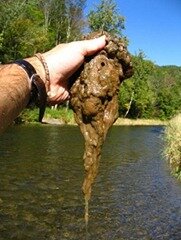Responsible fishing says good-bye to felt-soled wading boots

As anglers explore new waters and interact with nature in a uniquely participatory way, they often develop a conservation sensibility. Because, in spite of high tech fishing gear such as Gore-Tex waders, graphite rods, and felt-soled wading shoes, the first prerequisite for good fishing is clean water, and that depends on a resilient, intact ecosystem. Yet – regardless of how conservation-minded they might become – anglers are unwittingly damaging ecosystems by spreading invasive species such as Didymo from watershed to watershed with felt-soled waders.
Felt-soled boots were introduced in the late 1980’s. Because felt soles gave superior traction on slippery rocks and made wading swift rivers safer, they were quickly adopted by anglers. Since felt soles stay damp a long time, however, they are also a haven to transport invasive species such as Didymo (Didymosphenia geminate).
Didymo, also known more descriptively as “river snot,” is a prolific alga that, when blooms, covers a stream bed in a greenish-brown carpet up to 8” thick. Not only does it make the stream look hideous, it disrupts the aquatic ecosystem. Didymo is so prevalent in New Zealand that the use of felt-soled boots was banned in 2008. Didymo is also found in Canada and many states in the US, from New York and Pennsylvania to Montana and California.
A responsible angler who uses felt-soled waders has several options to prevent spreading Didymo and other invasives. One technique is to use different boots in different watersheds, which would ensure that invasives would not be transported among river systems. Such a solution, however, could result in an unwieldy number of boots. A simpler – but more labor-intensive – remedy is to disinfect the felts with Clorox and dry them out. This would kill any invasives hitchhiking in the felt.
The best way to prevent the spread of invasives with felts, naturally, is not to use felt-soled boots at all. Companies such as Orvis, LL Bean, and Simms have developed “sticky rubber” soles, which give good traction like felts, but dry out quickly like rubber boots. Although these shoes do not yet perform quite as well as felts, the technology is improving. At the request of Trout Unlimited, several manufacturers, including Orvis, LL Bean, and Simms, are phasing out felt-soled boots this year.
Related articles
So if you still use felt-soled boots, take the time to disinfect and dry them between fishing trips. If you don’t have the time for that (and, really, who does?), try investing in an alternative to felt-soled boots, such as or . You may not be able to wade as quickly and confidently as you did in felts. But, by slowing down, you just might find yourself catching more fish.
Photo - Tim Daley, Pennsylvania Department of Environmental Protection
Advertisement
Follow us

